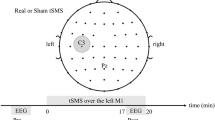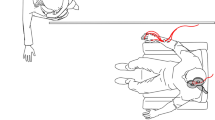Effects of anodal transcranial direct current stimulation (tDCS) of the motor cortex on heart rate variability (HRV) indices in healthy volunteers were examined. Baseline HRVs of 16 healthy subjects were recorded, and the HRV changes during anodal and sham tDCS stimulation over the vertex were observed. RM-ANOVA showed significant changes in the means of the high-frequency (HF) band, lowfrequency (LF) band, and LF/HF ratio (P < 0.0001, P = 0.012, and P = 0.01, respectively). A significant decrease in the LF/HF ratio was found during tDCS as compared to baseline (P = 0.033); this effect was mainly due to an increase in the HF band during active stimulation (P = 0.002 in active vs. baseline, and P = 0.007 in active vs. sham). A slight statistically insignificant decrease in the LF band and increase in the HF band induced a significance in comparison of the LF/HF ratio during sham stimulation. The increase in the HF HRV component reflects intensification of parasympathetic activity during anodal stimulation of the motor cortex. Possible explanations are activation of the motor cortex or a dominancy of the left hemisphere due to lateralized current flow. According to our results, neuromodulation of the motor cortex can be an adjuvant to maintain the autonomic balance in some neurological diseases.
Similar content being viewed by others
References
M. A. Nitsche and W. Paulus, “Excitability changes induced in the human motor cortex by weak transcranial direct current stimulation,” J. Physiol., 527, No. 3, 633e9 (2000).
F. Fregni, S. Thome-Souza, M. A. Nitsche, et al., “A controlled clinical trial of cathodal DC polarization in patients with refractory epilepsy,” Epilepsia, 47, No. 2, 335-342 (2006).
P. S. Boggio, S. P. Rigonatti, R. B. Ribeiro, et al. “A randomized, double blind clinical trial on the efficacy of cortical direct current stimulation for the treatment of major depression,” Int. J. Neuropsychopharmacol., 11, No. 2, 249-254 (2008).
M. A. Rueger, M. H. Keuters, M. Walberer, et al. “Multisession transcranial direct current stimulation [tDCS] elicits inflammatory and regenerative processes in the rat brain,” PLoS One, 7, No. 8, e43776 (2012).
L. A. Sampaio, R. Fraguas, P. A. Lotufo, et al. “A systematic review of non-invasive brain stimulation therapies and cardiovascular risk: implications for the treatment of major depressive disorder,” Front. Psychiat., 10, No. 3, 87 (2012).
Y. Vandermeeren, J. Jamart, and M. Ossemann, “Effect of tDCS with an extracephalic reference electrode on cardiorespiratory and autonomic functions,” BMC Neurosci., 11, 38 (2010).
R. A. Montenegro, P. T. Farinatti, E. B. Fontes, et al., “Transcranial direct current stimulation influences the cardiac autonomic nervous control,” Neurosci. Lett., 497, No. 1, 32e6 (2011).
A. R. Brunoni, M. A. Vanderhasselt, P. S. Boggio, et al., “Polarity- and valence-dependent effects of prefrontal transcranial direct current stimulation on heart rate variability and salivary cortisol,” Psychoneuroendocrinology, 38, No. 1, 58-66 (2013).
J. A. Clancy, R. Johnson, R. Raw, et al., “Anodal transcranial direct current stimulation [tDCS] over the motor cortex increases sympathetic nerve activity,” Brain Stimul., 7, No. 1, 97-104 (2014).
R. J. S. Raimundo, C. E. Uribe, and J. P. Brasil-Neto, “Lack of clinically detectable acute changes on autonomic or thermoregulatory functions in healthy subjects after transcranial direct current stimulation [tDCS],” Brain Stimul., 5, No. 3, 196e200 (2012).
S. Akselrod, D. Gordon, F. A. Ubel, et al., “Power spectrum analysis of heart rate fluctuation: a quantitative probe of beat-to-beat cardiovascular control,” Science, 213, No. 4504, 220e2 (1981).
M. Chapleau and R. Sabharwal, “Methods of assessing vagus nerve activity and reflexes,” Heart Fail Rev., 16, No. 2, 109e27 (2011)
A. Pascual-Leone, J. Valls-Solé, E. M. Wassermann, and M. Hallett, “Responses to rapid rate transcranial magnetic stimulation of the human motor cortex,” Brain, 117, 847-858 (1994).
R. Chen, L. G. Cohen, and M. Hallett, “Role of the ipsilateral motor cortex in voluntary movement,” Can. J. Neurol. Sci., 24, 284-291 (1997).
T. Yoshida, A. Yoshino, Y. Kobayashi, et al., ”Effects of slow repetitive transcranial magnetic stimulation on heart rate variability according to power spectrum analysis,” J. Neurol. Sci., 184, 77-80 (2001).
F. Vernieri, C. Altamura, P. Palazzo, et al., “1-Hz repetitive transcranial magnetic stimulation increases cerebral vasomotor reactivity: a possible autonomic nervous system modulation,” Brain Stimul., 7, No. 2, 281-286 (2014).
K. Udupa, T. N. Sathyaprabha, J. Thirthalli, et al., “Modulation of cardiac autonomic functions in patients with major depression treated with repetitive transcranial magnetic stimulation,” J. Affect. Disord., 104, 231-236 (2007).
G. Gulli, C. Tarperi, A. Cevese, et al., “Effects of prefrontal repetitive transcranial magnetic stimulation on the autonomic regulation of cardiovascular function,” Exp. Brain Res., 226, No. 2, 265-271 (2013).
V. G. Macefield, J. L. Taylor, and B. G. Wallin, “Inhibition of muscle sympathetic outflow following transcranial cortical stimulation,” J. Auton. Nerv. Syst., 68, 49-57 (1998).
R. F. Tavares, J. Antunes-Rodrigues, and F. M. de Aguiar Corrêa, “Pressor effects of electrical stimulation of medial prefrontal cortex in unanesthetized rats,” J. Neurosci. Res., 77, 613-620 (2004).
F. Cogiamanian, A. R. Brunoni, P. S. Boggio, et al., “Non-invasive brain stimulation for the management of arterial hypertension,” Med. Hypotheses, 74, No. 2, 332-336 (2010).
F. Vernieri, G. Assenza, P. Maggio, et al., “Cortical Neuromodulation modifies cerebral vasomotor reactivity,” Stroke, 41, 2087-2090 (2010).
F. Binkofski, M. Loebig, K. Jauch-Chara, et al., “Brain energy consumption induced by electrical stimulation promotes systemic glucose uptake,” Biol. Psychiat., 70, 690-695 (2011).
S. M. Oppenheimer, A. Gelb, J. P. Girvin, and V. C. Hachinski, “Cardiovascular effects of human insular cortex stimulation,” Neurology, 42, 1727-1732 (1992).
A. C. Miu, R. M. Heilman, and M. Miclea, “Reduced heart rate variability and vagal tone in anxiety: trait versus state, and the effects of autogenic training,” Auton. Neurosci., 145, 99-103 (2009).
E. G. Peniston and P. J. Kulkosky, “Alpha-theta brainwave neurofeedback therapy for Vietnam veterans with combat related post-traumatic stress disorder,” Med. Psychother., 4, 47-60 (1991).
N. C. Moore, “A review of EEG biofeedback treatment of anxiety disorders,” Clin. Electroencephalogr., 31, No. 1, 1-6 (2000).
J. L. Elghozi, D. Laude, and A. Girard, “Effects of respiration on blood pressure and heart rate variability in humans,” Clin. Exp. Pharmacol. Physiol., 18, No. 11, 735-742 (1991).
Author information
Authors and Affiliations
Corresponding author
Rights and permissions
About this article
Cite this article
Erdogan, E.T., Saydam, S.S., Kurt, A. et al. Anodal Transcranial Direct Current Stimulation of the Motor Cortex in Healthy Volunteers. Neurophysiology 50, 124–130 (2018). https://doi.org/10.1007/s11062-018-9726-2
Received:
Published:
Issue Date:
DOI: https://doi.org/10.1007/s11062-018-9726-2




